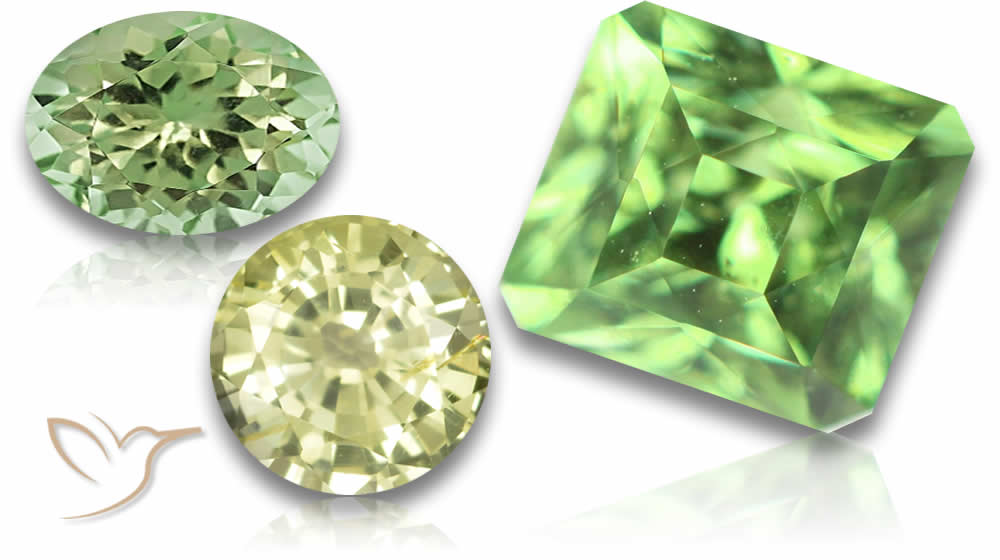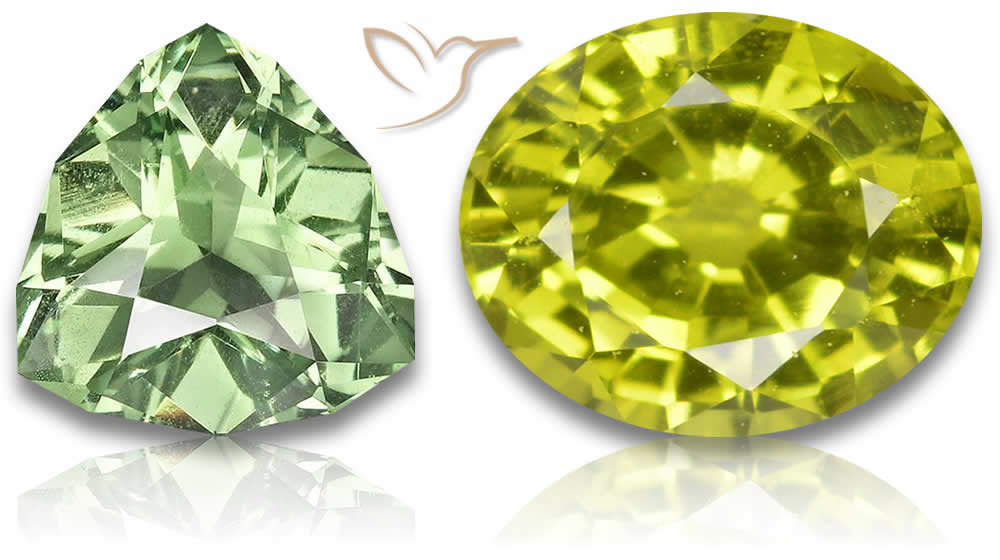Grossularite Garnet Guide: Colors & Value

Grossularite garnet is a gemstone that sparkles with vibrant colors and a rich history. From lush greens to soft pinks, this member of the garnet family has something for everyone - whether you're a collector, a jewelry lover, or just curious about gemstones. Known for its beauty and believed to bring emotional healing and prosperity (learn more about garnet’s meaning and powers), grossularite garnet is a semi-precious stone that’s both stunning and meaningful. In this guide, we’ll dive into its properties, colors, value, and how it shines in jewelry. Want a broader look at garnets? Check out All About Garnet. Let’s get started!
Table of Contents
- What is Grossularite Garnet?
- Color Variations
- Valuing Grossularite Garnet
- Grossularite Garnet in Jewelry
- Explore Other Garnet Varieties
- Frequently Asked Questions
- Conclusion
What is Grossularite Garnet?
Grossularite garnet, often called grossular garnet, is a rare gemstone in the garnet family, making it a standout among rare garnets. Its name comes from the Latin word "Grossularia," meaning gooseberry, thanks to its greenish-yellow hue that resembles the fruit. But don’t let the name fool you - this stone comes in a rainbow of colors, including a striking green garnet variant that’s a favorite in jewelry.
This gemstone is a calcium-aluminum silicate mineral with a Mohs hardness of 6.5 to 7.5, making it durable enough for everyday wear. Its vitreous to resinous luster and cubic crystal system give it a unique sparkle. Green grossularite garnet, colored by traces of chromium and vanadium, ranges from pale green to deep emerald and is primarily found in Kenya, Tanzania, and Mali, though it pops up in other parts of the world too.
Other colors include brown, yellow, orange, pink, and red, each adding to the stone’s allure. Whether you’re drawn to its physical properties or its rarity, grossularite garnet is a gem worth knowing about.
Color Variations
One of the coolest things about grossularite garnet? Its colors! This gemstone is like a painter’s palette, with hues shaped by trace elements and light absorption during its formation. Let’s take a closer look at the shades that make this stone so special, including how it compares to cousins like tsavorite garnet and hessonite garnet:
- Green Grossular Garnet: The star of the show, ranging from yellowish-green to a bold emerald hue, similar to tsavorite garnet but with its own unique vibe. It’s a go-to for jewelry because it’s just so eye-catching.
- Yellow Grossular Garnet: Think pale, almost colorless shades to deep gold or honey tones - perfect for a warm, sunny vibe.
- Orange Grossular Garnet: From soft peach to fiery burnt orange, this color adds a zesty pop, much like hessonite garnet’s warm tones.
- Red Grossular Garnet: Known as "raspberry grossular garnet," it ranges from delicate pink to rich crimson. Romantic, right?
- Brown Grossular Garnet: Light beige to deep mahogany, offering an earthy elegance.
- Other Colors: Pink, purple, and gray hues also appear, giving collectors even more to love.
The variety of colors makes grossularite garnet a gemstone you can’t ignore. When you’re picking one out, knowing what influences its color can help you find the perfect shade for you.
Valuing Grossularite Garnet
Not all grossularite garnets are priced the same, and there’s a good reason for that. The value of this gemstone depends on a few key factors, with color leading the pack. Planning to buy one? Check out the Garnet Buying Guide for expert tips. Let’s break it down:

The rarest and most vibrant colors - like intense greens, yellows, and oranges - fetch the highest prices. Clarity matters too; stones with fewer inclusions are more valuable. Size is another big factor, with gems over five carats being rare and pricey. And don’t forget the cut - a well-cut stone shows off its brilliance and color, boosting its worth.
Factors Determining Value
| Factor | Description |
|---|---|
| Color | The most critical factor. Intense greens, yellows, and oranges are the most valuable, with hue and saturation playing a role. |
| Clarity | Fewer inclusions mean higher value. Transparent, clear stones command top prices. |
| Size | Larger stones, especially over five carats, are rare and more valuable. |
| Cut | Well-cut stones maximize brilliance and color, increasing value. |
Market demand also swings the price. Green grossularite garnet, for example, is a collector’s favorite, driving up its value. If you’re buying, understanding these factors can help you snag a gem that’s worth every penny.
Grossularite Garnet in Jewelry
Ready to wear some sparkle? Grossularite garnet is a fantastic choice for jewelry, bringing bold color and elegance to any piece. Its rich hues and shiny luster make it a designer’s dream, and its durability (hello, scratch resistance!) means you can rock it every day.
You’ll find this gemstone in earrings, necklaces, bracelets, and rings, often paired with other semi-precious stones or metals for a stunning effect. Plus, it’s more affordable than some other gems, so you can get that high-end look without breaking the bank.
Popular Jewelry Designs
| Jewelry | Description |
|---|---|
| Ring | A solitaire ring with a round grossularite garnet is bold and perfect for making a statement. |
| Earrings | Dangling earrings with grossularite garnet stones work for both casual and fancy outfits. |
| Bracelet | A bracelet with calibrated grossularite garnet stones adds a delicate, feminine touch. |
| Necklace | A pendant necklace with a large grossularite garnet stone brings elegance to any look. |
Whether you love subtle or statement pieces, grossularite garnet has you covered. It’s versatile, beautiful, and ready to shine in your jewelry collection.
Explore Other Garnet Varieties
Explore Other Garnet Varieties
Frequently Asked Questions
What is Grossularite Garnet?
Grossularite garnet is a gemstone in the garnet family, known for its vibrant colors, including a striking green variant.
What are the physical and chemical properties of Grossularite Garnet?
It has a hardness of 6.5 to 7.5 on the Mohs scale and is a calcium-aluminum silicate mineral forming in a cubic crystal system.
Where is Grossularite Garnet found?
It occurs worldwide, including in Africa, Canada, Russia, India, and the United States.
Is Grossularite Garnet a birthstone?
Yes, it’s an official birthstone for January and a traditional gem for the 2nd wedding anniversary.
What influences the color of Grossularite Garnet?
Trace elements like chromium, iron, and manganese, along with light absorption, determine its color.
How is the value of Grossularite Garnet determined?
Color, clarity, cut, size, and market demand determine its value.
Can Grossularite Garnet be used in jewelry?
Absolutely! Its durability makes it ideal for rings, necklaces, earrings, and more.
Conclusion
Grossularite garnet is more than just a pretty gemstone - it’s a fascinating piece of nature’s art. From its gooseberry-inspired name to its dazzling array of colors, this semi-precious stone captivates collectors and jewelry lovers alike. Its durability and affordability make it a practical yet stunning choice for rings, necklaces, and more. For a deeper dive into the world of garnets, explore All About Garnet.
Here’s what to take away:
- Grossularite garnet is a semi-precious gem in the garnet family with unique colors and properties.
- Its value hinges on color, clarity, size, and cut, with green hues being especially prized.
- It’s a versatile choice for jewelry, perfect for both everyday wear and special occasions.
Whether you’re hunting for a January birthstone or just love gemstones, grossularite garnet is a treasure worth exploring. Got a favorite color or design idea? This gem’s got you covered!

